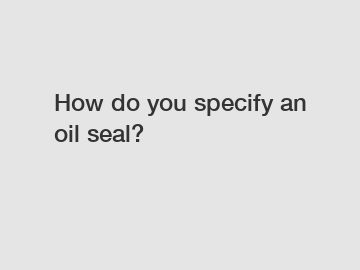Specifying an Oil Seal: A Comprehensive Guide.
Oil seals play a crucial role in preventing leaks and protecting machinery from contaminants. To ensure the proper functioning of your equipment, it is essential to specify the right oil seal for your application. With various options available in the market, choosing the correct oil seal can be a daunting task. In this article, we will discuss the key factors to consider when specifying an oil seal.
Material Selection.

The material of the oil seal is one of the most critical factors to consider. Different applications require different materials based on factors such as temperature, pressure, and the type of fluid being sealed. Common materials used for oil seals include Nitrile, Viton, Silicone, and Polyacrylate. Nitrile is suitable for general-purpose applications, while Viton is recommended for high-temperature and chemical-resistant applications. Silicone is ideal for extreme temperature ranges, and Polyacrylate offers improved oil resistance.
Size and Design.
When specifying an oil seal, it is essential to consider the size and design that will best suit your application. The inner diameter, outer diameter, and width of the oil seal must match the dimensions of the shaft and housing to ensure a proper fit. Additionally, the design of the oil seal, whether it be a single lip, double lip, or spring-loaded seal, should be chosen based on the requirements of the application.
Operating Conditions.
Understanding the operating conditions of the equipment is crucial when specifying an oil seal. Factors such as temperature, pressure, speed, and the type of fluid being sealed must be taken into account. High-temperature applications require oil seals with materials that can withstand heat, while high-pressure applications may require additional reinforcement such as a metal case or spring.
Shaft Surface Finish.
The surface finish of the shaft where the oil seal will be installed is another important consideration. The shaft must have the appropriate finish to ensure a proper sealing surface for the oil seal. A rough or damaged shaft surface can lead to premature wear and leakage. It is recommended to follow the manufacturer's guidelines for the required surface finish to ensure optimal performance.
Installation and Maintenance.
Proper installation and maintenance are key to the longevity and effectiveness of oil seals. It is essential to follow the manufacturer's recommendations for installation procedures to prevent damage to the seal or the equipment. Regular maintenance, such as checking for wear and tear and replacing seals when necessary, will help prevent leaks and costly repairs in the future.
Conclusion.
In conclusion, specifying the right oil seal is crucial for the proper functioning of your equipment. By considering factors such as material selection, size and design, operating conditions, shaft surface finish, and installation and maintenance, you can ensure that you choose the right oil seal for your application. If you need assistance in specifying an oil seal or have any questions, feel free to contact us.
Contact Us.
If you need help specifying an oil seal or have any questions, please do not hesitate to contact us. Our team of experts is here to assist you in finding the right oil seal for your application.
Want more information on 12014851b, 370006a, Agricultural Oil Seals? Feel free to contact us.





Comments
0